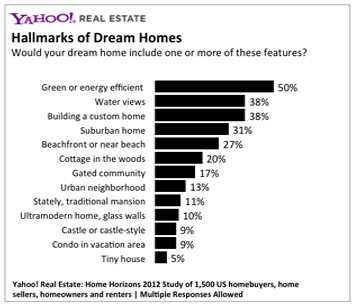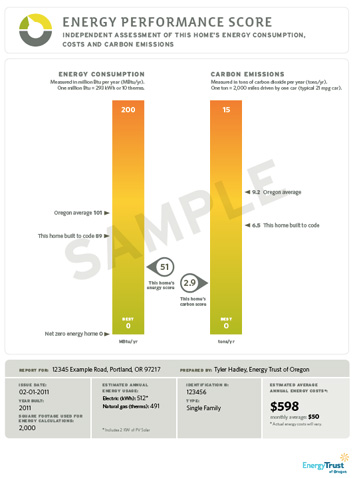Yahoo! Real Estate study and Appraisal Institute action show market is increasingly giving home performance its due.
Two recent pieces of news show that the market is beginning to understand and assign real value to home energy performance. This means that investments made in home energy retrofits and Passive House construction today are more likely to pay major dividends at resale. And if trends continue, this will be truer with each passing year.
Why? First, because Americans’ definition of their “Dream Home” is shifting away from the McMansion and toward the energy efficient, sustainable home. Second, because the real estate market is beginning to sort out how to assign value to “green features” like home energy efficiency and walkability.
The New American Dream Home: No Longer Your ‘90s McMansion
According to a new Yahoo! Real Estate survey of 1,545 “current and aspiring homeowners,” 81% still believe that homeownership is part of the American Dream.
But the h ouse in that dream looks different today, writes Yahoo!’s Rusty Weston:
ouse in that dream looks different today, writes Yahoo!’s Rusty Weston:
“The so-called American dream home isn’t a supersized McMansion – it is a ‘green,’ energy-efficient home built with ‘sustainable’ materials that yields a lower carbon footprint. Or, more often, it is a home remodeled with energy-efficient appliances and eco-friendly home products.”
The Yahoo! Real Estate Home Horizons study’s sanguine prediction for the coming year? “2012 is the year that demand for green homes, energy-efficient appliances and low-carbon impact home building materials reaches a tipping point in America.”
Yahoo!’s findings about the demand for energy efficiency and walkability is in line with the work of national thought leaders in urban studies. Christopher Leinberger, a senior fellow at the Brookings Institution, wrote in his recent NY Times opinion piece, “The Death of the Fringe Suburb”:
“It was predominantly the collapse of the car-dependent suburban fringe that caused the mortgage collapse. … Over all, only 12 percent of future home buyers want the drivable suburban-fringe houses that are in such oversupply. … It is time to instead build what the market wants: mixed-income, walkable cities and suburbs that will support the knowledge economy, promote environmental sustainability and create jobs.”
Home Appraisals That Value “Green”
So the demand is there for a more sustainable version of the dream home. But so is, increasingly, the real estate market’s ability to assign value to fundamental sustainable building characteristics like energy performance and walkability. This is important, because for “green building” to enjoy truly broad adoption, its added value must be incorporated into market transactions and recognized in home price.
 To this end, the Appraisal Institute made waves in late September by providing appraisers with a voluntary “Residential Green and Energy Efficient Addendum” to help assign value to “green features” like home energy performance. It’s a big step in the right direction, enabling appraisers to include things like insulation R values, HERS Rating, Walk Score, and home energy retrofit improvements into their home appraisals. And it’s downright revolutionary given how (understandably) cautious appraisers have become after the recent mortgage debacle. Read more about the implications of the new addendum in this daily5remodel.com blog post by Leah Thayer, entitled “Bling, Ka-ching and Green in New Appraisals.”
To this end, the Appraisal Institute made waves in late September by providing appraisers with a voluntary “Residential Green and Energy Efficient Addendum” to help assign value to “green features” like home energy performance. It’s a big step in the right direction, enabling appraisers to include things like insulation R values, HERS Rating, Walk Score, and home energy retrofit improvements into their home appraisals. And it’s downright revolutionary given how (understandably) cautious appraisers have become after the recent mortgage debacle. Read more about the implications of the new addendum in this daily5remodel.com blog post by Leah Thayer, entitled “Bling, Ka-ching and Green in New Appraisals.”
But bigger things are afoot, too, with the eventual (we hope) requirement to include an MPG-like Energy Performance Score in every MLS real estate listing. With this Energy Performance Score showing the energy consumption and performance of every home up for sale, buyers will have the information they need to do informed comparison shopping, and homeowners will be fully rewarded and time of resale for the energy performance improvements they make. Energy performance (or lack thereof!) will become reflected in home price.
The Market Is Catching Up
As we’ve written before, improving your home’s performance or investing in a Passive House makes sense on purely non-financial grounds. High performing houses are comfortable, healthy, and environmentally-responsible places to live. But we all know that these investments represent a major financial decision. Higher-performing buildings cost less to operate – often much less. So there’s always been a compelling time-to-payback argument to be made in favor of home performance remodels and Passive Houses (e.g.. “in X years my utility bill savings will have offset the cost of making Y performance investment.”)
But now, as evidenced by the Yahoo! study and the Appraisal Institute’s green addendum, the real estate market is catching up, beginning to recognize both the intangible and quantifiable value of green building and incorporating that value into real estate transactions. That’s good news for homeowners, for green builders like Hammer & Hand, and, ultimately, for carbon emissions reduction.
Not a moment too soon.
– Zack
Back to Field Notes